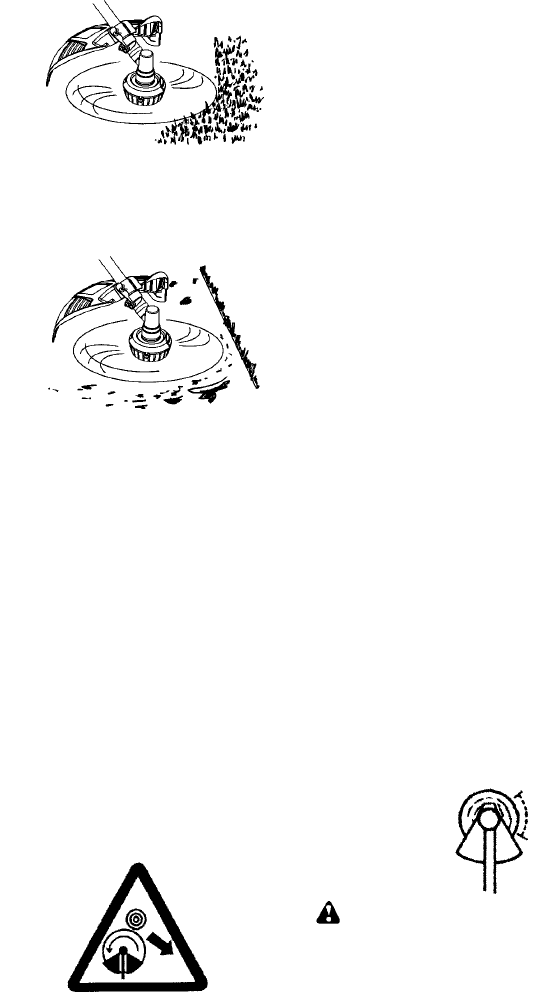
12
Mowing
SWEEPING-- Thefanningactionof therotat-
inglinecanbeusedtoblowaway loosedebris
from an area. Keep the line parallel to and
above the area surface and swing the tool
from side to side.
Sweeping
OPERATING INSTRUCTIONS FOR
USE WITH WEED BLADE
S Blade Thrust is a reaction that only occurs
when using a bladed unit. This reaction can
cause serious injury such as amputation.
Carefully study this section. I tis importantthat
you understand what causes blade thrust,
how you can reduce t he chance of its
occurring, and h ow you can remain in control
of unit if blade thrust occurs.
S WHAT CAUSES B LA DE T HR UST -- Bla d e
Thrust can occur when the spinning blade
contacts an object that it does not cut. This
contact c ausesthe b l adetostopforaninstant
and th en suddenly move o r “ thrust” a way
from the object that was hit. The “thrusting”
reaction can be violent enough to cause the
operator to be propelled in any direction and
lose control of the unit. The uncontrolled unit
can cause serious injury if the blade contacts
the operator or others.
S WHEN BLADE THRUST OCCURS --
Blade Thrust can occur without warning if
the blade snags, stalls, or binds. This is
more likely to occur in areas where it is
difficult to see the material being cut. By
using the unit properly , the occurrence of
blade thrust will be reduced and the
operator will be less likely to lose control.
S Cut only grass, weeds, and woody brush up
to 1 cm in diameter with the weed blade. Do
not let t he blade contact material it cannot cut
such as stumps, rocks, fences, m etal, etc., or
clusters of hard, woody b rush having a
diameter greater than 1 cm.
S Keep the blade sharp. A dull blade ismore
likely to snag and thrust.
S Cut only at full throttle. The blade will have
maximumcutting powerand isless likely to
bind or stall.
S “Feed” the blade deliberately and not too
rapidly.Thebladecan thrust away ifit isfed
too rapidly.
S Cut onlyfrom yourleft t oyour right.Cutting o n
right side of the shield will throw debris away
from the operator .
S Use the shoulder strap and keep a firm grip
on the unit with both hands. A properly
adjusted shoulder strap will support the
weight of the u nit, freeing your a rms and
hands tocontrol a nd guidethe cuttingmotion.
S Keep feet comfortably spread apa rt and
braced for a possible sudden, rapid thrust of
unit. Do not overreach. Keep firm footing and
balance.
S Keep blade below w aist level; it will be
easier to maintain control of unit.
S Donotraisetheengineaboveyourwaistas
the blade can come dangerously close to
your body.
S Do not swing unit with such force that you
are in danger of losing your balance.
Bring the engine to cutting speed before enter-
ing the material to be cut. If the blade does not
turnwhenyousqueeze thethrottle t rigger,make
sure shaft is fully inserted into the engine.
Always release the throttle trigger and allow
engine to return to idle speed when not cut-
ting. The blade should not turn while the en-
gineisrunningatidle. Ifthebladeturnsatidle,
donot useyour unit .Referto theCARBURE-
TOR ADJUSTMENT section or contact your
authorized service dealer .
S Maintain good firm footing while using the
unit. Do this by planting feet firmly in a
comfortable apart position.
S Cut while swinging the upper part of your
body from left to right.
S Asyoumoveforwardtothenextareatocut,
be sure to maint ain your balance and footing.
Cut using the 2
o’clock t o 4 o’clock
position of the
blade
2 o’clock
4 o’clock
RECOMMENDED CUTTING POSITION
WARNING: The operator or others
mustnottrytoclearawaycutmaterialwiththe
engine running or the blade turning to avoid
serious injury . Stop engine and blade before
removing m aterials wrappedaround bladeor
shaft.


















